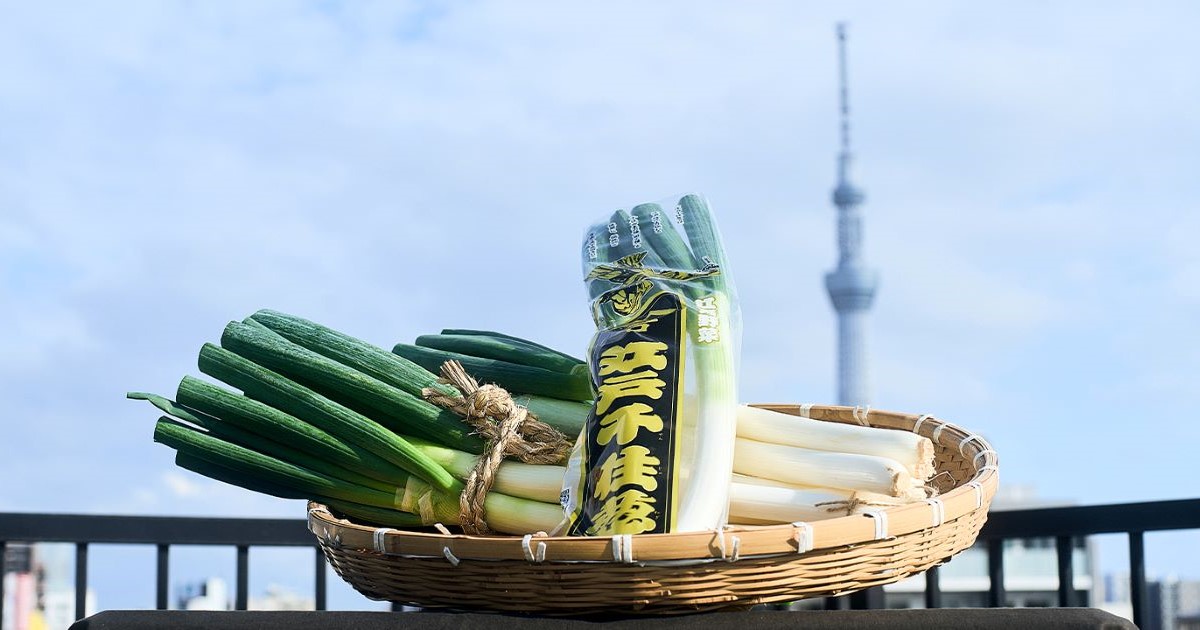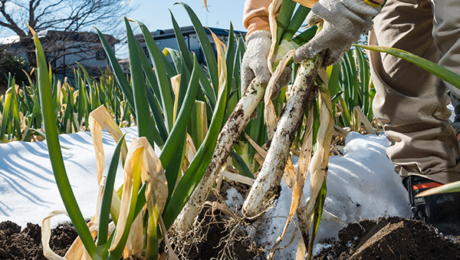

Negizen: Tale of the Revival of Edo White Spring Onions
2024.12.17
FOODAs winter approaches, so does the season of hotpot dishes, with negi (spring onions) playing a starring role in Japanese staples such as sukiyaki and yosenabe. Among the varieties, the nebuka negi—also known as naga-negi (long spring onion) or shiro-negi (white spring onion) for its long, white stalk—comes into peak season from autumn through winter, earning its place as the centerpiece of many winter meals. In fact, this iconic vegetable is said to trace its origins to Edo (modern-day Tokyo).
Originally, only the green leaves of negi were consumed. However, during the Edo period, farmers from Osaka began cultivating them in Edo, only to find that the cold winters caused the leaves to wither. Left with no choice, they buried the stalks in soil, inadvertently discovering that the white part, when cooked, emitted a delightful aroma and tasted sweet instead of spicy. From this discovery, farmers began to cultivate longer white stalks, purportedly leading to the birth of the nebuka negi.
The nebuka negi spread from the Sunamura area of Koto City to the Senju market, where it became known as Senju negi and gained widespread popularity among Edo residents. Tsunehiro Tanaka, the fourth-generation head of spring onion wholesaler Negizen, explains, “The white part of the negi must have been incredibly delicious. It’s remarkable how people back then devised techniques like covering the stalks with soil to make them grow longer. It’s thanks to their ingenuity that we have the white negi we enjoy today.”

For Tanaka, Senju negi represents a nostalgic taste of his childhood. However, like many traditional vegetables, these negi faced challenges: they were prone to disease, pests, and heat sensitivity, and their inconsistent sizes made them unsuitable for mass production. Consequently, traditional varieties gradually disappeared from the market.
Hearing elderly customers reminisce about how leeks “used to taste so much better,” Tanaka resolved to revive this lost flavor. Over more than a decade, with the support of local farmers, he succeeded in restoring traditional negi through trial and error. To distinguish this variety from modern cultivars, Negizen branded it as Edo Senju Negi.
On the appeal of Edo Senju Negi, Tanaka says simply, “It’s delicious—nothing more, nothing less.” Its bold spiciness, strong enough to make you exclaim out loud, embodies the essence of a traditional vegetable that retains the original flavor of negi. It also stands out for its strong aroma and firm texture, and its strikingly large and thick size is quite the eye-catching feature.
However, as Edo Senju Negi is only available in winter, Negizen utilizes its 140-year-old network, unique to a long-established company, to consistently provide high-quality Senju-type negi throughout the year. Carefully selected by experts, these negi are branded as Negizen Senju Negi, a name that reflects the company’s unwavering dedication to taste and quality.

The transformation of white negi through heat is their defining feature, much as it amazed Edo residents centuries ago. When cooked, the leeks soften into a luscious, velvety texture, and their sharp spiciness disappears, giving way to a distinctive, gentle sweetness. This versatility makes white negi, more than a traditional garnish, a main ingredient—grilled with a pinch of salt, deep-fried as tempura, or incorporated into a wide array of dishes. Even the green leaves are edible, making the entire leek a culinary treasure.
Of the many ways to prepare leeks, for Tsunehiro Tanaka, president of Negizen, “Grilling is probably the best.” He also recommends slicing them finely, mixing them with katsuobushi and soy sauce, and serving the mixture over rice. However, his true favorite is miso soup with leeks. He explains, “Pile a generous amount of chopped leeks into your bowl first, then pour the miso soup over them. This way, the leeks gently cook, releasing their aroma and flavor, allowing you to fully savor their essence.”
Tsunehiro Tanaka’s son Yasuaki, who works alongside his father, adds, “White negi are a product of Edo’s food culture.” Just as Edo-style soba is incomplete without white negi, they carry the spirit of Edo’s rich history and traditions. This winter, why not enjoy Yasuaki’s own favorite negima nabe (spring onion and tuna hotpot) and reflect on the Edoites who cherished the unique flavor of white negi?






